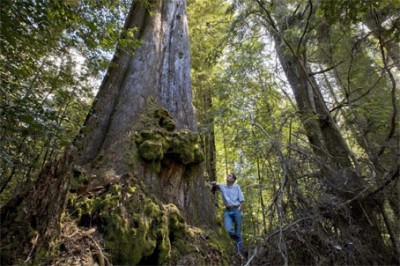A new forest study finds compelling evidence for halting the logging of mature forest in Australia, but the old forestry debate with its entrenched positions are a big obstacle to progress. [12 August 2008 | Peter Boyer]
If you’re looking for a metaphor for confusion or concealment, chances are you’ll turn to forest or fire. They can’t see the forest for the trees, for example. Or, he’s hiding behind a smokescreen.

Mature forest in Tasmania’s Florentine Valley. Prof Mackey says that such forests hold over 1200 tonnes of carbon per hectare. Photo Rob Blakers
In the endless forestry “debate” (too civilised a word for this often-mindless wrestling match), Tasmanians are bushed – another forest metaphor – when it comes to working out the impact of logging on atmospheric carbon levels.
“The public deserves facts about forest management, based on science, not opportunistic media relations and spin,” Bob Gordon, Forestry Tasmania’s managing director, said earlier this year. It’s advice the forest industry itself would do well to heed.
Last week’s report on carbon storage in Australian forests by an Australian National University team led by Professor Brendan Mackey begs for a considered response tackling the specific findings of the report. Instead it got just the same tired old generalisations.
We need to be aware that the Wilderness Society helped to fund the Mackey report, but this is hardly grounds for the logging industry to dismiss it as “flawed”. Are they implying that Prof Mackey, a senior forest scientist, skewed his results to please the Wilderness Society?
Prof Mackey and his team concluded that the amount of carbon in unlogged Australian forest was nearly three times the estimate used to determine policies under the Kyoto Protocol, and that Tasmania’s tallest forests – including some areas marked for logging – held as much as six times the Kyoto figure.
If all or most of the forest’s carbon were retained indefinitely in wood or paper products, this might not matter. But there’s evidence that an awful lot of it finishes up in the atmosphere.
A 2001 Weld Valley study commissioned by Forestry Tasmania estimated that the smoke from a post-logging fire in wet eucalyptus forest contained 196 tonnes of carbon per hectare. That would make Tasmania’s annual logging burns a very large emitter of carbon dioxide.
But Forestry Tasmania doesn’t seem to want to quote this data, and as far as I can tell it has not funded any on-the-ground, verifiable, quantitative carbon research in the seven years since. This puts it in a weak position to criticise the Wilderness Society for supporting such studies.
Premier David Bartlett said he had no plans to conserve more Tasmanian forests and that “conflicting” research showed the benefits of plantation forestry. But plantations are a red-herring in the context of carbon storage in mature native forests. Replacing such forests with regrowth or seedlings is like emptying a bank vault of centuries of accumulated treasures to make way for slowly-accumulating new deposits.
Regardless of how quickly a growing new forest can capture carbon, at issue is the loss of any part of the existing carbon store in our mature forest in the critical years to 2020. To avoid dangerous climate change we need deep cuts in emissions now, not in a decade or two.
Sidelining the Mackey report may win the forest industry breathing space to continue logging mature forests, but in the long term we may all be losers. Somehow we have to skirt the mire of the forestry wrangle and get to the truth – quickly.
As Bob Gordon says, we need “facts… based on science, not opportunistic media relations and spin”.
• Climate change and environment issues are at the forefront of work this year by over 220 students and teachers from around Tasmania who have been preparing for this week’s Tasmanian Youth Environment Conference. This unique eisteddfod-like education and environment event, at the Derwent Entertainment Centre today, involves kids teaching kids on climate change and environment issues, and in hands-on environment workshops.
